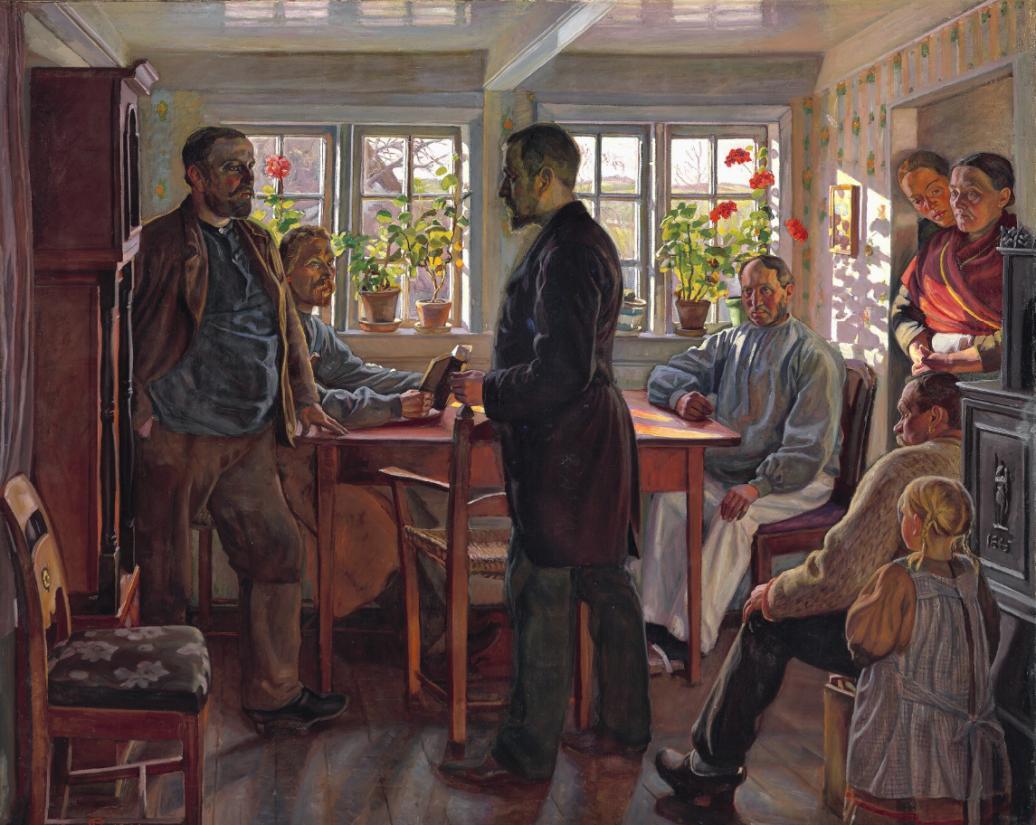The painting Den Fremmede (The Stranger) from 1900–01 shows a group of smallholders or workers gathered inside a small, low-ceilinged farmhouse living room. The painting enters into dialogue with one of Syberg’s principal pieces in Faaborg Museum’s collection, Aftenleg i Svanninge Bakker (Evening Play in Svanninge Hills) from 1900–02. Together, the paintings illustrate the artist’s different approaches to portraying figures.
The stranger
The figures are close together: two men are sitting at the table, a third person is sitting in the corner by the stove with his back turned to us, and two women are standing in the doorway. In the lower right corner, we see a young girl, also with her back turned. Almost all the figures are focusing on the two men standing face to face in the middle of the room. The man in the centre of the composition stands out as an outsider in his elegant black clothes and leather shoes. With these features, Syberg establishes that he is a stranger. The room feels crowded due to the many people and pieces of furniture packed into the small space. The cramped atmosphere adds to the intensity of the confrontation between the two men, and the viewer clearly senses the tension in the room. However, the tense atmosphere is contrasted by the warm daylight pouring through the multi-pane windows. Filtered through the green leaves of the geraniums on the windowsill, the sunlight throws beautiful shadows on the patterned wallpaper.
Two works of art relating to each other
The painting is interesting seen in relation to Syberg’s other portrayal of a group, Aftenleg i Svanninge Bakker, which depicts a group of people in the hilly landscape on the island of Funen. As in Den Fremmede, some of the figures are seen from the back. Here, however, the figures appear small in relation to the wide open landscape where they are dancing, and the scene has a harmonious feel in contrast to the tense atmosphere in the interior painting. While the dancing figures almost seem to disappear in the hilly landscape, the figures in the small farmhouse room seem almost uncomfortably large. The two pieces illustrate the artist’s different approaches to portraying figures in terms of both colours and technique. Among the common features, both paintings are portrayals of groups and show figures who are absorbed by the situation; this lends the pictures an intimate feel.
About Fritz Syberg
Fritz Syberg (1862–1937) was part of the artist group the Funen Painters, which also included Johannes Larsen and Peter Hansen. He drew inspiration from everyday life in the home he made with his wife, Anna: family meals, Anna with the children, interior scenes from their beautiful, simple home or the rural setting on Funen. Syberg grew up in poverty in the town of Faaborg on Funen. From a young age he had to provide for himself and his siblings by working as a pig boy. As an adult, he rose above the dire circumstances of his childhood and distinguished himself as an artist. He took lessons from Peter Syrak Hansen and married Hansen’s daughter Anna. Later, during stays in Copenhagen, he took lessons from Kristian Zahrtmann at Kunstnernes Frie Studieskoler (The Artists’ Free Study Schools).



